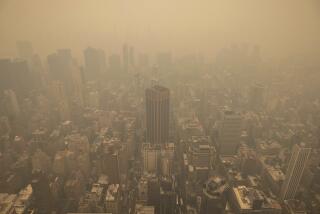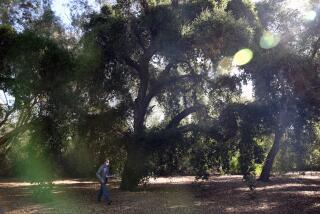Sneezin’ Season
It’s going to be a very long spring for the millions of Californians who suffer from allergies and asthma.
And nobody knows that better than Josephine Gunther.
“I’m having a really hard time breathing. My head and my sinuses are pounding,” said Gunther, of Lake Forest. Gunther visited an allergist Wednesday for a series of skin tests. “My ears are stuffed up, which makes it hard to hear. I’m thinking I’m allergic to everything.”
Soon, about 500,000 other allergy sufferers in Orange County may be sympathizing.
With almost 14 inches of rainfall, Orange County has endured the wettest February on record, and allergy doctors say the merciless rain is going to bring a skyrocketing pollen count along with lush, green grasses and abundant wildflowers.
“El Nino is going to create a lot of health problems this year,” said Dr. Lakshmi S. Duriseti, a Lake Forest allergist. “The amount of vegetation has grown tremendously. This rain is going to bring an added burden.”
Along with a potential rise in pollen counts, the rains have caused an increase in mold spores, which can also aggravate asthma and allergic rhinitis. Also known as hay fever, allergic rhinitis is one of the most common chronic illnesses and affects 35 million Americans, according to Dr. Joel E. Lewis, a Costa Mesa allergist.
Asthma and hay fever are set off by microscopic proteins found in pollen, Duriseti said. Some people’s immune systems recognize the proteins as foreign and react, causing congestion and inflammation of the nasal passages and bronchial tubes, and countless swipes at tissue boxes.
Though April is usually a peak time for doctor visits, local allergists are already reporting a 20% to 30% increase in patients. Fortunately, there’s hope for the ailing.
Many preventive measures and medications can make life bearable for those who battle sneezing, runny noses, itchy eyes, scratchy throats and other uncomfortable symptoms at certain times of the year. Environmental control is crucial. Mold spores grow in dark, damp places, according to Dr. Geeta Venkat, a Mission Viejo allergist.
“Garages, basements, bathrooms that aren’t ventilated properly, even piles of wet leaves can be breeding grounds for mold spores. They can make life miserable for some people,” she said.
Getting to the root of musty or mildewy smells is key, Venkat said. Undetected water leaks can also nurture mold. Household bleach will kill mold spores. A dehumidifier also can help.
As for pollen, it’s best to shut your windows and use an air-conditioner.
Keeping windows open at night is especially risky since the pollen count is highest from 4 to 6 a.m., Venkat said. “People who like to sleep with their windows open can wake up with an awful stuffy nose,” she said.
Common-sense guidelines include avoiding exercise early in the morning when pollen counts are highest, and trying to steer clear of trees, grasses and weeds that can set off sneezing. Common culprits include olive, oak, mulberry and eucalyptus trees; rye, oat, Bermuda and Kentucky Blue grasses; and weeds and wildflowers, such as mustard, found on hillsides.
Portable air purifiers and vacuum cleaners with high-efficiency particulate air filters can reduce airborne particles that can set off allergies, Lewis said.
And medications such as non-sedating antihistamines and anti-inflammatory nasal sprays can keep occasional allergy attacks at bay. For those with more severe symptoms, a series of injections can block allergic reactions.
Karen Blanco of San Juan Capistrano found relief when she opted for the injections.
“During the rain, my allergies definitely get worse,” Blanco said. “Almost every change in weather affects them. I have my own internal barometer. But I have been getting shots for the past three years and it has helped immensely.”
(BEGIN TEXT OF INFOBOX / INFOGRAPHIC)
The Big Sneeze
Pollen from flowers and trees triggers many allergic reactions this time of year. A look at common respiratory allergies and how to control them:
Common Causes
Airborne particles, smaller than a pinhead, can cause sneezing. Some examples:
* Grass pollen
* Tree pollen
* Mold spores
* House-dust mites
* Animal dander (flakes of dead skin)
*
Prevention
* Close car windows when driving
* Clean air-conditioner or furnace filters often
* Buy specially made filters to capture fine airborne particles
* Sleep with windows closed
* Don’t exercise between 5 and 10 a.m. on high-pollen days
* During warm weather, close windows and use air-conditioning to reduce indoor pollen
*
Help Resources
For referrals to allergists and/or educational material, call:
* Asthma & Allergy Foundation of America, (800) 624-0044
* The American Academy of Allergy, Asthma and Immunology, (800) 882-2762
* The American College of Allergy, Asthma & Immunology, (800) 842-7777
*
Treatment
Over-the-counter products may help alleviate symptoms, but controlling severe allergic reactions may take a visit to an allergist. Some common allergy remedies:
* Antihistamines: Control sneezing, itching
* Oral corticosteroids: Prevent asthma symptoms from developing
* Immunotherapy: Injects allergens to block allergic reaction.
Sources: World Book Encyclopedia, The American Medical Assn. Encyclopedia of Medicine, Times reports
More to Read
Sign up for Essential California
The most important California stories and recommendations in your inbox every morning.
You may occasionally receive promotional content from the Los Angeles Times.










